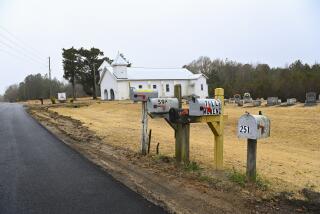Slicing and dicing the world, with maps
- Share via
The marketing folks at Absolut must have been enjoying a few bottles of their own vodka when they decided the way to sell their product was with a map of the U.S. drawn at a time when much of the West belonged to the government south of the border. The “Absolut World” ad featuring a much larger Mexico and a reduced Estados Unidos could hardly have been more neatly calculated to dredge up Mexican resentments and jab at U.S. fears.
Absolut pulled the ad after post-1848 boundary aficionados in the U.S. threatened to go back to drinking bourbon. That’s one crisis averted. But while the Swedish vodka maker’s map may be an example of ill-advised marketing, artistic tinkering with longitude and latitude has long been used to express popular, and often unpopular, views on how the country could be better organized. Over the years, redrawn maps of the United States and of the world have reflected the ambitions, prejudices, politics and big ideas of the mapmakers.

An early effort at alternative cartography in American history came when the United States and Britain were haggling over the final disposition of the Oregon territory, and James K. Polk won the presidency with the slogan “Fifty-four-forty or fight,” a reference to Polk’s (possibly insincere) wish for the U.S. to take over the entire territory, up to the border of what was then Russian Alaska. Though the Oregon boundary dispute ended without violence and Canada now stretches from sea to sea, the notion of dissolving what is now the line between Washington state and British Columbia has come up again, in drastically different contexts.
During secession and the Civil War, the map of the United States briefly did change, as the southern states formed the short-lived and never very united Confederate States of America. The CSA map has figured prominently, both directly and indirectly, in post-Civil War American politics, most recently in the post-2004 election web meme which sought to associate states that voted to re-elect President Bush with the former Confederacy. George B. Kirchner offers a version of the CSA map modestly dubbed “the Historic First Definitive Map of the Confederate States of America.”
Liberal suspicions about the values of the so-called Red States have made for some pretty creative maps in recent years. The popular Jesusland map credited to G. Webb, a commenter at yakyak.org, depicts a Canadamerican rump state which combines the purportedly more progressive states and provinces, leaving a kind of bible-belt-and-suspenders through the heartland of both countries. The Jesusland map has spawned a small culture of alt-cartography and parody.
Ultimately, however, no work of parody could be as surreally fascinating as the “purple America” maps that display the actual 2000 and 2004 presidential election results on a county-by-county basis. Depending on your point of view, these maps depict a hopelessly divided or an intriguingly mixed up nation.
Just as often, alternative maps have expressed regional pride or just in-your-face-ness. Nearly 40 years before The New Yorker magazine’s celebrated 1976 Manhattan-über-alles cover, New Yorker Daniel K. Wallingford put the “Big” in the Big Apple with this chart of Gotham chauvinism. And since nothing is bigger than Texas, Mark Storm did the same thing for Lone Star State a few years later.
Not all fictional maps have expressed territorial ambition or regional pride, however. In 1981 Joel Garreau laid out his thesis of “The Nine Nations of North America” in a book by that title. In Garreau’s bold vision, regions of the continent would in the future sort themselves into had sorted themselves into more coherent regional arrangements based on common interest (so that, for example, Vancouverites and San Franciscans might find they had more in common with each other than either had with, respectively, Ottawans or Washingtonians)*. If the Nine Nations map was good to the regions, it was hell on existing governments: Only Quebec survives more or less intact. (Tellingly, Los Angeles becomes part of “Mexamerica” in Garreau’s plan.)
And then some maps tell us the mapmakers’ ideas about not just the U.S. or North America but the world, often with a personal twist. Seeking to sum up the progress made in his presidency, Dwight D. Eisenhower endpapered his memoir Waging Peace with world maps showing his own travels and the U.S. ring of alliances. The maps are not invented, but they offer wonderful insights into Ike’s views of his own part in history and of the geopolitics of the 1950s.
Finally, some mapmakers take the broadest view possible. If, for example, your travels take you out of the plane of the ecliptic and you need to make an indirect return to planet Earth, you may find the common view of North as up and South as down just too parochial for practice. Back when the United States was being founded and the British surrendered at Yorktown, the Redcoats’ band played a march called “The World’s Turned Upside Down.” Or maybe they didn’t. In any event, there’s a map to cover either of these situations.
* An earlier version of this article misstated Joel Garreau’s thesis. Thanks to Joel Garreau for the correction and for some interesting comments below.
More to Read
Sign up for The Wild
We’ll help you find the best places to hike, bike and run, as well as the perfect silent spots for meditation and yoga.
You may occasionally receive promotional content from the Los Angeles Times.






